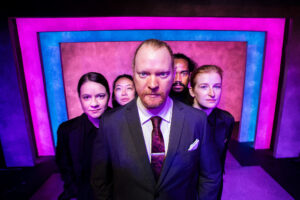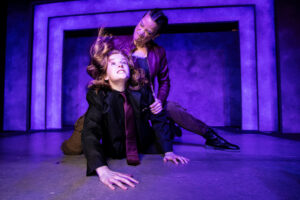
 **** The world premiere production of “The S Paradox” is an innovative combination of science fiction and dystopian drama. Based on a smart script by award-winning playwright Jillian Leff, the action takes place in both the years 2100 and 2120. In this future time period, guns have been outlawed, and it is only law enforcement who can use knives and swords.
**** The world premiere production of “The S Paradox” is an innovative combination of science fiction and dystopian drama. Based on a smart script by award-winning playwright Jillian Leff, the action takes place in both the years 2100 and 2120. In this future time period, guns have been outlawed, and it is only law enforcement who can use knives and swords.
The first 45 minutes are a dream. This is five-star scriptwriting! In 2100, Sloane (Kayla Marie Klammer), fails her final examination to become a police officer by not executing a criminal in a realistic 3-D simulation; rather, she apprehends the suspect with a humanistic touch. Consequently, a sympathetic weapons cache officer named Dez (Elisabeth Del Toro) surreptitiously presents her with a prized sword even though its ownership is reserved only for those who graduate from the police academy. Sloane is subsequently approached by the smooth-talking William Hale (Steve Peebles) together with his aides, all called The Nameless (Deanna Palmer, Jessica Pennachio, and Thomas Russell). William convinces Sloane that she is made for bigger and better things and gets her to work for him as a spy in a highly top-secret branch of the FBI, called the CRC. Sloane has a live-in girlfriend named Ava (Cat Evans), who is unhappy with Sloane’s new line of work, and there is also a shopkeeper/gym attendant (Tina-Kim Nyguen) who Sloane is also acquainted with. Finally, a time traveler from the year 2120 named S (Maureen Yasko) constantly tries to go back in time with the assistance of Older Dez (Sonja Lynn Mata), who is a science and technology wizard. I’m being deliberately vague in my descriptions, because saying anything more would ruin the plot.
While the use of physical violence is to be expected in a Babes with Blades theatrical performance, the uses of swordfighting and other forms of combat are fully integral to this particular story, as compared to being an add-on just for the sake of displaying female prowess. Kudos to Samantha Kaufman, the fight director, who has done a remarkable job choreographing the close contact among the characters and making their bouts look authentic. I particularly liked the casting for both Sloane and S, plus their costumes by Rachel M. Sypniewski are incredibly well done: a cross between the modern clothing of today and a futuristic Robin Hood. Practically all the costumes are spot on, although the black and white outfit worn by Dez looks silly and much too sloppy. (She may be the “mad scientist”, but that’s no excuse for making her unkempt.) Set design is minimal, basically a cascading set of frames that hold lights that are lit up indirectly. Thanks to lighting designer Laura J. Wiley, what is especially marvelous in this production is the flickering of lights and their changing colors whenever S goes back and forward in time. The psychedelic effect created by the lights combined with the acting is highly imaginative. Prop design is also relatively minimal but effective, due to the work of Evy Burch. With just a few pieces of furniture on wheels, we get the idea of a living space and other locales. Sound design by L.J. Luthringer could not have been better. And the directing by Morgan Manasa is great! For such a small stage, every bit has been used to the hilt, and the movement constantly flows throughout. I especially liked the scenes when the locus of action takes place in a room which the audience must imagine from what we have seen previously.
The biggest fault with the show is that S goes back into the past and returns to her present moment far too many times. Each time, it is Old Dez (or Dez in 2120) who assists her with her time travel. But when Old Dez is constantly explaining everything that she is doing with her computer and with time windows, this is far too much of a data dump. The audience cannot follow it all, nor it is necessary to do so. While my interest was never lost during these explanations and escapades, the thread of the story gets disrupted in the process. It does pick up again maybe 20 minutes later; but by then, the story has lost its head of steam. Yes, time travel is important to the plot, but some of these trips ought to be consolidated and explained in plain English rather than scientific gobbledygook. Even a detailed lecture about the Heisenberg Uncertainty Principle in relation to time travel would have been better, and then, the explanation is necessary only once. This is important, because a simpler discussion would have made the ending clearer to the audience, and I had to explain it to my guest. Fundamentally, we are dealing with several timelines all at once, which is why the play is called the S Paradox! (Did I reveal too much about the plot???) While my guest actively liked seeing so many trips back and forth in time, our main area of disagreement had to do with the character of Dez. I thought that she and Old Dez were both overly chirpy and overacted, while my guest loved her enthusiasm.
This is a fun and easy-going story, but a scary one too. You will like it even if science fiction is not your genre and even if you don’t fully understand the ending. The principal characters are acted well, although several of the minor characters need to be fleshed out better and tweaked. Largely told from a feminist perspective, the tale is easily relatable independent of race, class, gender, or sexual orientation. In fact, the character of Sloane is one that we can all identify with. Life throws out the possibility of moving in one of many directions, and there are crucial moments when we have to make important decisions about the trajectory that our lives must go. Figuring out what we want to do, what we have to do, and what is the ethical thing to do—in addition to navigating life’s challenges—can very tricky. That’s why Sloane’s predicament is so universal, since it deals with the life choices which she is confronted with and her thinking process about them. In addition to Leff’s intriguing plot and character analysis, there are several larger points which the playwright makes that shine a light on the political, economic, and social situation of the world today. There’s a lot going on in this play, but for the most part, it is excellent and relatively easy to follow. While some aspects need further honing, Leff has created a compelling script that holds the audience’s attention and speaks to us on lots of levels.
“The S Paradox” is playing through May 18, 2024, at The Factory Theater, 1623 W. Howard Street, in Chicago.
Tickets for the live and the streaming productions are $28 – $35.
 Live performance schedule:
Live performance schedule:
Thursdays, Fridays, and Saturdays – 8 p.m.
Sundays – 3 p.m.
Streaming dates are Saturday May 11 at 8 p.m.; Sunday, May 12 at 3 p.m.; Thursday, May 16 and Friday, May 17 at 8 p.m.
Open Caption performances are available Saturday, May 4 at 8 p.m.; Sunday, May 5 at 3 p.m., and Thursday and Friday, May 9 and 10 at 8 p.m.
Sensory-Friendly performances are on Sundays, April 21 and 28 at 3 p.m.
For more information and to purchase tickets, visit https://babeswithblades.org/.
To see what others are saying, visit www.theatreinchicago.com, go to Review Round-Up and click at “The S Paradox”.






More Stories
“Survivors” reviewed by Julia W. Rath
“Prayer for the French Republic” reviewed by Julia W. Rath ( and another by Paul Lisnek)
“Obliteration” reviewed by Mark Reinecke